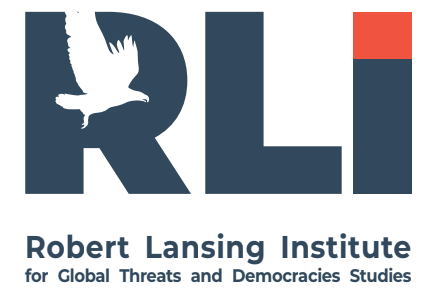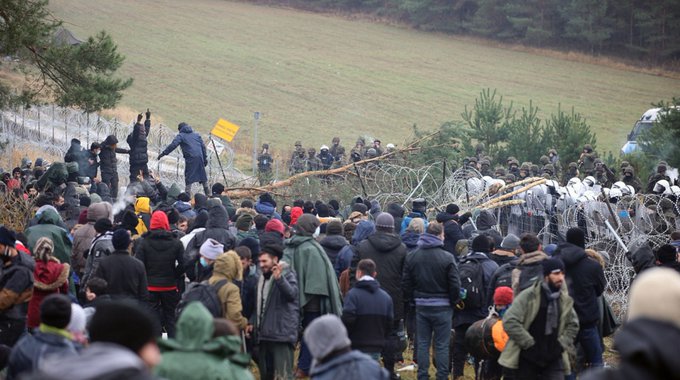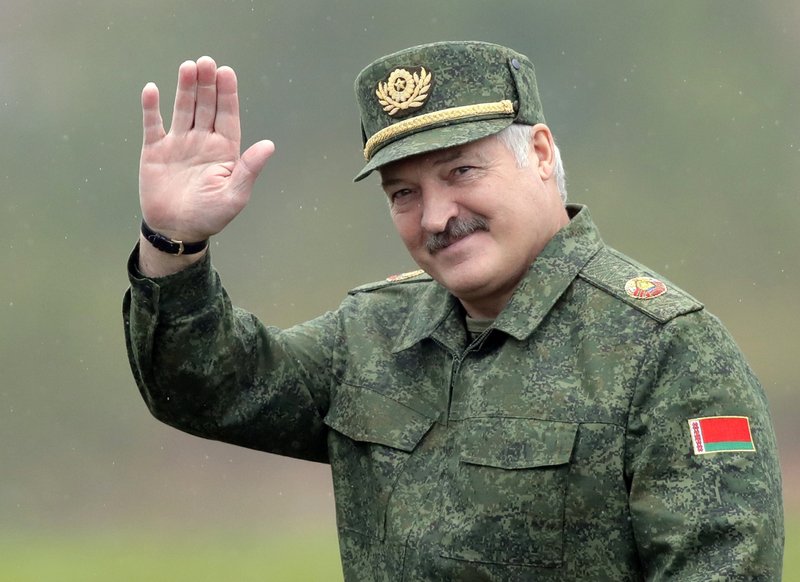On 2 November 2025, information was published that in October Lithuania recorded the highest number in the past six months of attempted illegal crossings from Belarusian territory—275. Nearly half of these occurred during the last five days of the month, when Vilnius closed the border following drone incursions carrying contraband cigarettes. Since the beginning of 2025, Lithuanians have already stopped more than 41,000 violators—20% more than last year. Vilnius believes the migration flow is controlled by Belarusian security services and used as an element of hybrid pressure on the EU.
Of the 275 attempted illegal entries from Belarus, almost half (116, or 42%) were recorded in the last five days of the month—after Lithuania closed the border with Belarus due to drone incursions carrying smuggled cigarettes. On 31 October 2025, the highest single-day number of attempted illegal crossings in the past three years was registered—63.
Overall, last month EU neighboring countries recorded 3,271 attempts to illegally cross the border from Belarus—14.9% fewer than in September (3,844), and 47.9% more than in October 2024 (2,211).
In the first 10 months of 2025, 41,160 attempts were prevented—20.6% more than in the same period last year (34,132), and 13.4% more than in all of 2024 (36,291).
In the summer–autumn of 2021, Lithuania, Latvia, and Poland faced a large-scale migration crisis caused by an influx of refugees from Middle Eastern countries entering EU territory via Belarus. The authorities of the three states stated that the Belarusian authorities organized the transport of migrants for money—bringing them to Minsk through a state tourist company and then driving them to the border. Minsk categorically denied its involvement in these operations.
The situation is another episode in the tense relations between Minsk and Vilnius, which have a complicated history of border conflicts and political disagreements. There have been incidents involving the use of weather balloons to deliver contraband cigarettes from Belarusian territory into Lithuania. These, in particular, led to disruptions at airports. Lithuania’s President Gitanas Nausėda assessed these incidents as a hybrid attack on his country, which must be met with both symmetric and asymmetric responses;
• Lukashenko maintains that Lithuanians “themselves were launching cigarettes from Belarusian territory on meteorological balloons” in order to profit from resale. According to him, Belarusian citizens “legally purchased cigarettes from the manufacturer and passed them to Lithuanians who came onto Belarusian territory, taking their cut, while Lithuanian citizens allegedly transported the goods to their accomplices with the help of balloons.”
In response, the Lithuanian government decided to close for a month the Medininkai and Šalčininkai border checkpoints on the border with Belarus. The EU views Minsk’s actions as a hybrid attack and is considering the possibility of introducing new sanctions against Belarus; a prolonged closure of the border by Vilnius could become a serious economic challenge for Minsk. A reduction in transit volumes and restrictions on the movement of goods will lead to logistics delays and rising costs for Belarusian exporters. Over time, this will weaken the financial resilience of Lukashenko’s regime and increase its dependence on Moscow.
Heightened migration pressure on the EU’s eastern borders remains one of the key instruments of the hybrid policy of Minsk and Moscow. The organized flow of illegal migrants is combined with cyberattacks, disinformation campaigns, and drone attacks, creating multidimensional pressure on the West. The goal of these actions is to sow discord within the European Union and undermine trust among member states.
The rise in attempted illegal entries from Belarusian territory into Lithuania does not necessarily indicate a new crisis, but it does point to an escalation of the border situation. This may be Minsk’s response to new restrictions rather than evidence of a deliberate escalation. Lithuanian authorities do not yet characterize the situation as a crisis, but they are closely monitoring the dynamics and coordinating actions with partners in the EU.
A potential new migration crisis could have serious domestic political consequences for the EU’s border countries. Growing tensions at the border may fuel public discontent, strengthen the positions of radical political forces, and weaken governments that support Ukraine. Moscow and Minsk may exploit this factor to divert the West’s attention from the war in Ukraine and diminish the unity of the Western coalition in support of Kyiv.
Political Context Behind Belarus’s Orchestrated Migration Crisis
The migrant crisis on the EU’s eastern frontier must be understood against a backdrop of deteriorating relations between Belarus and the European Union. Tensions spiked after Belarus’s long-time ruler, President Alexander Lukashenko, claimed victory in the August 2020 presidential election – a vote widely denounced as fraudulent by the Belarusian opposition and Western countries. Mass protests erupted and were met with a brutal crackdown by Lukashenko’s security forces. In response to the post-election repression and human rights abuses, the EU (along with the United States) imposed successive rounds of sanctions on Belarusian officials and entities. These sanctions aimed to pressure Lukashenko’s regime over electoral fraud and the violent suppression of dissent. Relations deteriorated further in May 2021, when Belarusian authorities forcibly diverted a Ryanair flight to Minsk and arrested a dissident journalist on board, provoking international outrage. This brazen incident led the EU to adopt tougher sanctions, including banning Belarusian carriers from EU airspace. At this point, Lukashenko’s regime openly threatened retaliation: in late May 2021, he declared that Belarus would no longer stop migrants and drugs from crossing into Europecongress.gov. “We were stopping migrants and drugs – now you will catch them yourselves,” Lukashenko warned, explicitly linking this stance to the Western sanctions and diplomatic pressure his government faced. Indeed, at the end of June 2021, Belarus unilaterally suspended a Belarus–EU readmission agreement, which had required Minsk to accept the return of migrants who entered the EU via Belarus. This suspension signaled that Belarus would no longer cooperate on stemming irregular migration, effectively opening the floodgates.
Soon after Lukashenko’s threats, evidence mounted that the Belarusian authorities were facilitating an influx of migrants from the Middle East and other regions toward EU borders. By summer 2021, large groups of people from countries like Iraq, Syria, Yemen and others were flying into Minsk – lured by Belarusian state-linked travel agencies and false promises of easy entry into the EU. Belarus loosened its visa rules for Middle Eastern nationals and offered “tourist packages” that included quick visas on arrival, flights, and accommodations in Belarus. State-owned enterprises such as Tsentrkurort (subordinate to the presidential administration) coordinated with travel agencies to bring in migrants under the guise of tourism and even “hunting trips,” exploiting loopholes in COVID-19 travel restrictions. According to investigations by journalists, Belarus’s government-directed scheme arranged for migrants to be transported to the borders of Lithuania, Poland, or Latvia. Upon arrival, Belarusian security forces often escorted or directed these groups to EU border crossings, and even supplied tools like wire cutters and axes to help breach border fences. Migrants later recounted that Belarusian guards sometimes prevented them from turning back and forced them to remain at the frontier, effectively using them as pawns in a geopolitical game.
This state-engineered influx began to overwhelm Belarus’s EU neighbors by mid-2021. For example, Lithuania – which had seen fewer than 100 irregular migrants in the entire year prior – suddenly apprehended hundreds of border crossers in June–July 2021. By August, Lithuanian authorities had detained over 4,000 migrants arriving from Belarus (mostly Iraqis and Syrians), a colossal increase from double-digit figures in previous years. The crisis soon spread to Poland and Latvia as preferred routes, especially in the autumn. In early November 2021, dramatic scenes unfolded on the Belarus–Poland border: thousands of migrants massed in makeshift camps in the freezing woods, trapped between Polish border guards on one side and Belarusian forces on the other. The humanitarian situation deteriorated sharply – the camps lacked adequate shelter, food or medicine, and at least 10 people died from exposure and hypothermia in those harsh conditions. Belarusian guards continued to escort groups of migrants to border points and reportedly even fired shots in the air to intimidate them into pushing forward into Poland. When desperate migrants attempted to storm the Polish border fencing at Kuznica Bruzgi crossing in mid-November, Polish forces repelled them with water cannons and tear gas, while Belarusian officers looked on. The situation reached a fever pitch that drew in top-level diplomacy: then-German Chancellor Angela Merkel took the unusual step of phoning Lukashenko twice in one week to discuss humanitarian relief, a move that indicated the severity of the crisis and Lukashenko’s apparent leverage. Shortly thereafter, Belarus eased the immediate pressure – clearing the main camps and allowing repatriation flights for some migrants – but only after having created a months-long standoff that riveted and alarmed Europe..
Belarusian Government’s Motivations
European officials and analysts widely agree that Lukashenko’s regime engineered the migrant flows as a form of retaliation and pressure against the EU. After the EU sanctioned Belarus for its election fraud and human rights violations, Lukashenko sought to “weaponize” migration as a hybrid warfare tactic. The Belarusian leadership explicitly stated it was responding to what it perceived as Western aggression: in August 2021, Lukashenko remarked that the EU had “put us in such conditions that we have to react… and we are reacting in the best way we can”. By deliberately funneling migrants toward Poland, Lithuania and Latvia, Minsk aimed to punish and destabilize those neighboring states (all EU members) for supporting the Belarusian opposition and for lobbying EU sanctions. Lukashenko’s calculus was that triggering a migrant crisis would hit the EU at a known weak spot – its internal divisions and public sensitivities over immigration. The 2015 refugee influx had revealed how politically fraught migration can be for Europe, so Belarus anticipated that sending waves of asylum-seekers to EU borders would strain European unity and pressure EU governments to reconsider their hard line against his regime.
Additionally, Minsk had domestic and strategic motives for “stirring up” this crisis. EU leaders argued that Lukashenko was cynically distracting attention from Belarus’s internal repression by creating chaos at the border. Indeed, while the world’s focus shifted to migrants at the frontier, Lukashenko continued a crackdown on remaining dissent at home. The migrant scheme also became a bargaining chip: by manufacturing a problem that directly affected EU countries, Lukashenko hoped to force Western leaders to engage with him (despite previously shunning him as an illegitimate ruler). The fact that Chancellor Merkel and other European officials eventually had to communicate with him about humanitarian corridors validated, in Lukashenko’s eyes, his leverage. Some observers noted that Lukashenko likely sought a degree of international legitimacy by inserting himself into a crisis negotiation, showing that Europe could not ignore him. Finally, there was a propaganda angle: by provoking Poland into tough border enforcement (such as pushing back migrants with force), Belarus could generate images of suffering and conflict to fuel anti-EU narratives. Belarusian (and Russian) state media eagerly seized on scenes of Polish guards in riot gear confronting refugees, using them to accuse the EU of hypocrisy and inhumanity. In sum, Belarus’s strategy was a deliberate “instrumentalization” of vulnerable people – deploying migrants as pawns to achieve political ends. The European Union formally condemned this as an “orchestrated instrumentalisation of human beings for political purposes” by the Belarusian regime.
Belarus’s strongman president, Alexander Lukashenko, was the chief architect of this coercive strategy. In power since 1994, Lukashenko has a history of using unconventional means to maintain his rule, and the migration gambit was another extension of his authoritarian playbook. Embittered by international isolation and personal sanctions – the EU had directly sanctioned Lukashenko and his inner circle for the 2020 crackdowns – he personally authorized the border operation as retaliation. Lukashenko even admitted, with a dose of sarcasm, that Belarusian border troops might be helping migrants, saying such involvement was “absolutely possible” once videos emerged of Belarusian guards actively assisting crossings. Publicly, however, Lukashenko’s government denied orchestrating the crisis, insisting it had “nothing to do” with the migrants’ plight and blaming Western policies for the situation. This denial rang hollow to the EU. Evidence from intelligence and migrant testimonies clearly pointed to a state-directed operation – from Minsk granting fast-track visas, to state-owned companies arranging flights, to Belarusian security forces physically ferrying people to the borders.
Lukashenko’s personal stake in the affair was high. By unleashing this “migration warfare,” he aimed to hit back at neighbors like Poland and Lithuania (vocal critics who harbored Belarusian exiles) and to pressure the EU into acknowledging him. The fact that Western leaders eventually dialogued (albeit reluctantly) with him to resolve the border standoff was touted by Belarusian state media as a victory for Lukashenko – portraying him as an indispensable interlocutor. Domestically, the crisis was also used to rally his base with defiant rhetoric. Lukashenko framed his actions as defensive – a sovereign response to Western “hybrid aggression” – thereby tapping into nationalist sentiment. Throughout the crisis, he remained combative: when asked about the migrants, Lukashenko mockingly said “I’m not going to hold anyone by force… If they [migrants] keep coming, I won’t stop them, because they’re not heading to Belarus – they’re heading to your Europe”. Such statements underlined that Lukashenko was willing to flout international norms to extract concessions. Indeed, European officials accused him of deliberately endangering human lives for political gain. The crisis underscored Lukashenko’s role as a rogue actor in Europe – one prepared to manufacture instability beyond his borders to ensure his regime’s survival.
Another critical layer of context is Belarus’s alliance with Russia. Since the 2020 Belarusian election fallout, Lukashenko has leaned heavily on Russian support – financially, militarily, and diplomatically – to stay in power. Moscow’s backing emboldened Lukashenko to confront the West. While there is no concrete evidence that Russia directly organized the migrant flows, Russia’s role loomed in the background. Polish leaders went so far as to call President Vladimir Putin the “mastermind” behind the crisis, arguing that Lukashenko would not orchestrate such a bold challenge without the Kremlin’s blessing. Observers note that the timing and tactics benefited Russian interests: the border crisis not only distracted Europe, but also fed into Russia’s ongoing information war. Russian officials loudly defended Belarus’s handling of migrants and turned the tables to criticize the EU. Putin and Russian state media accused European governments of failing to uphold humanitarian ideals – pointing to Poland’s hardened response as evidence of Western double standards. The Kremlin thus amplified the propaganda value of the crisis, portraying EU states as heartless and Belarus (and by extension Russia) as comparatively sympathetic.
Strategically, the crisis unfolded as Russia was gearing up for major military exercises (Zapad 2021) near NATO’s eastern flank, and shortly before Russia’s military buildup around Ukraine later that year. Many in Europe viewed the migrant influx as a form of “hybrid warfare” coordinated (or at least condoned) by Moscow and Minsk in tandem. NATO’s Secretary General Jens Stoltenberg warned in August 2021 that the alliance was watching Belarus’s “hybrid activities” closely. For Putin, supporting Lukashenko served to bind Belarus closer and to test the EU’s resolve. In a phone call with Angela Merkel, Putin pointedly suggested that the EU deal directly with Lukashenko to resolve the border crisis – effectively reinforcing Lukashenko’s leverage. Thus, while the immediate trigger was Minsk’s feud with the EU, the Belarus-orchestrated migrant crisis also reflected the broader Belarus-Russia alignment against Western pressure. Russia’s tutelage and backing of Lukashenko provided the assurance that Belarus could pursue such an aggressive strategy without fear of regime collapse. In summary, Moscow’s role was one of an enabler and beneficiary – it propped up Lukashenko throughout the showdown and exploited the situation to undermine the EU, even if it stopped short of overt involvement in the logistics of moving migrants.
From the outset, European Union leaders condemned the situation as a “hybrid attack” orchestrated by the Belarusian regime – essentially viewing it as state-sponsored aggression under the guise of a migration crisis. The EU High Representative Josep Borrell, speaking on behalf of all member states, decried the “cynicism” of Minsk’s actions and the “inhumane instrumentalization” of migrants to achieve political ends. European officials stressed that Belarus was deliberately creating a humanitarian crisis at the EU’s external border to destabilize the Union and “distract attention from the situation in Belarus, where brutal repression and human rights violations are continuing”. In other words, the EU framed the influx not as a spontaneous refugee wave but as a coercive strategy by Lukashenko’s regimein retaliation for EU sanctions. European Commission President Ursula von der Leyen and Council President Charles Michel both rallied member states to stand firm against what was described as “state-sponsored migrant smuggling”. The EU’s immediate response was one of solidarity with the affected frontline members (Poland, Lithuania, Latvia) and resolve not to cave in to blackmail.
Diplomatic and Political Measures: The EU engaged in intensive diplomacy to stem the flow of migrants at the source. It worked with the migrants’ countries of origin and transit – for example, pressing Iraq to halt direct flights to Belarus and persuading Turkey to bar certain Middle Eastern nationals from boarding Belarus-bound flights. These efforts yielded results: Iraq suspended flights to Minsk and even organized repatriation flights for Iraqis stranded at the border. The EU also threatened to sanction any airlines (even non-European ones) involved in ferrying migrants to Belarus. Von der Leyen warned that carriers “active in human trafficking”would be blacklisted, prompting airlines in the Middle East to curtail routes exploited by smugglers. At the same time, the EU expanded its own sanctions regime against Belarus. In November 2021, Brussels broadened the legal criteria so it could target individuals and entities “organising or contributing” to Lukashenko’s migrant operations. This paved the way for new sanctions on Belarusian officials, state airline Belavia, and travel companies complicit in the scheme. “We will not accept any hybrid attack that exploits human beings in this way,” an EU joint statement declared, emphasizing that using migrants as pawns “cannot be tolerated”. By early December 2021, the EU imposed a fresh round of sanctions specifically in response to the border crisis, signalling its determination to hold Minsk accountable.
On the ground, the EU supported its member states’ border defenses (within legal limits). Poland and the Baltic states had quickly declared states of emergency and deployed thousands of border guards and troops to seal their frontiers. The Polish government characterized the situation as being “under attack” by Belarus. The EU and NATO largely endorsed this view: European Council statements affirmed that the Union “will not accept any attempt by third countries to instrumentalise migrants for political purposes”. Several EU capitals offered practical help. The European Commission, for instance, sent Frontex border agency personnel and patrol vehicles to Lithuania during the summer surge, and proposed financial aid for border management (although it stopped short of funding border wall construction directly). Twelve EU governments voiced support for building physical barriers on the EU’s external border in response to Belarus. At Poland’s request, however, media and aid agency access to the immediate border zone was restricted – a policy that drew some criticism from human rights groups but was defended in the name of security and avoiding Lukashenko’s propaganda. The EU sought to strike a balance between robust border protection and humanitarian principles, emphasizing that while it stood with Lithuania, Latvia, and Poland in shielding the EU’s border, it also expected Belarus to uphold migrants’ fundamental rights and allow humanitarian assistance. Notably, when Belarus refused entry to EU aid convoys for the migrants, European officials blasted Minsk for cruelty.
International and Legal Measures: The crisis also prompted discussions within NATO and the UN. Some EU members, pointing to the coordinated nature of the influx, floated the idea of invoking NATO’s Article 4 (consultations on threats to territory). While a formal Article 4 was not ultimately called, NATO did increase monitoring, and allies condemned Belarus’s hybrid tactics. The United Nations High Commissioner for Refugees (UNHCR) and International Organization for Migration (IOM) intervened as well, urging Belarus (and Poland) to abide by international refugee law and allow access to the stranded migrants. The EU backed these calls for humanitarian treatment even as it insisted the responsibility for the crisis rested squarely with Lukashenko’s regime. By late 2021, as emergency measures took effect and winter set in, the migrant flows decreased significantly from their peak. Many migrants were voluntarily repatriated or relocated with international assistance. The immediate standoff subsided, but EU officials remained wary. The episode led the EU to launch work on new measures to counter the “instrumentalisation” of migration – ensuring it can respond faster and more cohesively if an autocratic neighbor tries to engineer a similar crisis in the future.
In summary, the 2021 Belarus-organized migration crisis was not a spontaneous exodus, but a politically manufactured pressure campaign. It was rooted in Lukashenko’s clash with the EU over his undemocratic rule and was enabled by his alliance with Russia. By deliberately channeling migrants toward EU borders, Lukashenko sought revenge for EU sanctions, attempted to sow division within the EU, and aimed to extract concessions or recognition. The European Union interpreted this as a form of hybrid warfare – “an attack on all of us in the EU,” as German Chancellor Merkel put it – and responded with a mix of firmness and outreach: bolstering border security, ramping up sanctions on Belarus, and coordinating international action to cut off the migrant pipeline. The crisis escalated through the latter half of 2021, reaching a crescendo in November with tense confrontations at the Poland–Belarus frontier, before de-escalating after concerted EU and diplomatic pushback.
Crucially, the political context of this episode underscores how migrants were used as tools in a geopolitical struggle. The Belarusian regime’s willingness to exploit human misery for political leverage drew widespread condemnation as a breach of international norms and human rights. The EU’s unified response – treating the situation not as a mere migration issue but as a hostile state-sponsored provocation – demonstrated a resolve to not be coerced by such tactics. While the immediate crisis has abated, its legacy is evident in ongoing EU policy debates on strengthening external borders and on deterring the “instrumentalization of migration” by hostile actors. The Belarus-organized migrant crisis thus became a sobering case study in hybrid threats at Europe’s borders, one that has reshaped EU thinking on both security and asylum policy going forward.
Belarus’ Scheme to Send Migrants to the EU
Recruitment in Middle East & Africa
Belarusian authorities, travel agencies, and Belarus-linked intermediaries:
- Advertised “tourist trips to Europe” on social media.
- Promised easy entry to EU (Poland/Lithuania/Germany).
- Targeted Iraq, Syria, Yemen, Turkey, Congo, Cameroon, and others.
Migrants were led to believe Belarus was a gateway to the EU.
Visas and Travel Arrangements
Belarus:
- Simplified visa procedures for Middle Eastern & African nationals.
- Issued visas through embassies/consulates and “tour packages”.
- State-owned Tsentrkurort coordinated invitations.
Travel agencies sold packages including:
- Flight to Minsk
- Hotel in Belarus
- Border transport to EU
Some packages cost $4,000–$10,000 per person.
Flights to Minsk
Belarus coordinated with airlines to increase flights from:
- Baghdad, Erbil, Dubai, Damascus, Istanbul, Beirut, Amman.
Special charters arrived to Minsk. Some were arranged via:
- Belavia (state airline).
- Middle Eastern and Turkish carriers (later restricted under EU pressure).
Transport to EU Borders
After arrival:
- Belarusian security services gathered migrants
- Transported them to forests near Poland, Lithuania, Latvia
- Often provided:
- Wire cutters.
- Shovels,
- Axes,
- Border crossing instructions.
Migrants were guided to breach the EU border fence.
Forced Presence at the Border
Belarusian border guards:
- Prevented migrants from returning to Minsk,
- Pushed them toward EU fence lines,
- Fired shots in the air to intimidate them.
- Confined them in freezing forests as “human pressure tools”
This created humanitarian scenes meant to pressure the EU.
Core Purpose
Lukashenko used migrants as:
- Hybrid-warfare tools
- Retaliation for EU sanctions after the 2020 Belarus protests crackdown
- Political leverage to force dialogue with EU leaders
- Destabilization tactic to sow division inside the EU
He explicitly threatened:
If you sanction us, we will send drugs and migrants to Europe.
Main Migrant Routes
Origin → Minsk → Belarus–EU border → Attempted entry into:
| Route | Entry Country | Final Goal |
| Middle East/Africa → Minsk | Lithuania, Poland, Latvia | Germany & Western Europe |
Key Characteristic
This was not a refugee crisis — it was a state-engineered migrant weaponization operation.
EU definition: “instrumentalisation of migrants for political purposes.”
Belarus lured migrants by selling fake “EU entry packages,” flew them into Minsk, transported them to borders, and pushed them across as a geopolitical weapon against Europe

More on this story: Is Lukashenko starting a new migrant crisis?

More on this story: Increased Libya → Belarus Flights: Analysis of Causes, Actors, Timing, and Risks

More on this story: Belarus-Poland border: conflict resolution scenarios






